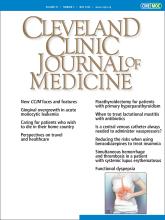A 55-year-old man presented to the emergency department with a 2-month history of progressive gingival swelling and oral pain. Physical examination revealed marked diffuse gingival overgrowth with necrotic lesions throughout the upper and lower gingivae (Figure 1). Complete blood cell count showed a marked leukocytosis of 100.2 × 109/L (reference range 4.0–10.5) with 11% blasts and few Auer rods. Bone marrow biopsy revealed 80% myeloblasts and promonocytes, cell profiling consistent with acute monocytic leukemia, subtype M5 based on the French-American-British (FAB) classification system. Cytogenetic and molecular studies were consistent with intermediate-risk acute monocytic leukemia.
Gingival overgrowth.
The patient received induction treatment with idarubicin and cytarabine (7+3 chemotherapy). On repeat bone marrow aspiration and biopsy on day 28 after completing induction therapy, 2% myeloblasts were present, warranting 4 additional cycles of consolidation chemotherapy with high-dose cytarabine combined with oral midostaurin due to the presence of the FLT3 mutation at diagnosis. His course was complicated by septic shock due to streptococcal bacteremia, requiring a prolonged intensive care unit stay. After recovery, he continued maintenance midostaurin and underwent evaluation for allogeneic stem cell transplant.
The patient’s gingival overgrowth resolved with the completion of induction chemotherapy (Figure 2).
Gingiva after completion of induction chemotherapy.
DISCUSSION
Gingival overgrowth is seen as an initial extramedullary manifestation of acute leukemia in about 5% of cases.1 It occurs most commonly in acute monocytic leukemia (FAB M5) and acute myelomonocytic leukemia (FAB M4), with an estimated occurrence rate of 66% in the M5 subtype.2
When considering the etiology of gingival overgrowth, clinicians must be aware of gingival changes that can occur with certain medication classes. These include immunosuppressants (eg, cyclosporine, tacrolimus, sirolimus), anticonvulsants (eg, phenytoin, sodium valproate, phenobarbitone), and calcium channel blockers (eg, nifedipine, amlodipine, felodipine).3 Other causes of gingival overgrowth include deficient periodontal health, sarcoidosis, Crohn disease, tuberculosis, and rare hereditary conditions.4
The mechanism of acute leukemia–related gingival overgrowth is believed to be related to massive leukemic infiltration in the gingival connective tissue.1,2,4
Although hematologic causes of gingival overgrowth are rare, clinicians must be aware of the association between gingival hyperplasia and acute leukemia, and obtain screening hematologic profiles (complete blood cell count with differential, coagulation studies) in patients presenting with symptoms of gingival overgrowth or other periodontal abnormalities.
DISCLOSURES
The authors report no relevant financial relationships which, in the context of their contributions, could be perceived as a potential conflict of interest.
- Copyright © 2024 The Cleveland Clinic Foundation. All Rights Reserved.








